

Ammbar - Gray day of rain.jpg. Science fantasy. Cover of the magazine Imagination, October 1950 Science fantasy is a mixed genre within the umbrella of speculative fiction which draws upon tropes and elements from both science fiction and fantasy, and sometimes also incorporates elements of horror.
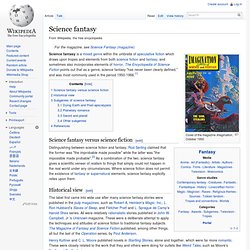
The Encyclopedia of Science Fiction points out that as a genre, science fantasy "has never been clearly defined," and was most commonly used in the period 1950-1966.[1] Science fantasy versus science fiction[edit] Distinguishing between science fiction and fantasy, Rod Serling claimed that the former was "the improbable made possible" while the latter was "the impossible made probable".[2] As a combination of the two, science fantasy gives a scientific veneer of realism to things that simply could not happen in the real world under any circumstances. Where science fiction does not permit the existence of fantasy or supernatural elements, science fantasy explicitly relies upon them. Historical view[edit] Henry Kuttner and C. Speculative fiction. History[edit] In mythography the concept of speculative fiction has been termed "mythopoesis" or mythopoeia, "fictional speculation", the creative design and generation of lore, regarding such works as J.R.R.
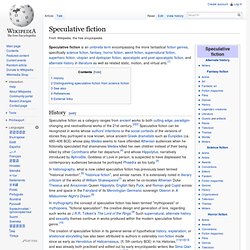
Tolkien's The Lord of the Rings.[9] Such supernatural, alternate history and sexuality themes continue in works produced within the modern speculative fiction genre.[10] The creation of speculative fiction in its general sense of hypothetical history, explanation, or ahistorical storytelling has also been attributed to authors in ostensibly non-fiction mode since as early as Herodotus of Halicarnassus, (fl. 5th century BCE) in his Histories,[11][12][13] and was already both practiced and edited out by early encyclopaedic writers like Sima Qian (ca. 145 or 135 BCE–86 BCE), author of Shiji.[14][15] In its English language usage in arts and literature since 20th century, "speculative fiction" as a genre term is often attributed to Robert A.
Heinlein. See also[edit] History Genres Themes. Materialism. Materialism is a form of philosophical monism which holds that matter is the fundamental substance in nature, and that all phenomena, including mental phenomena and consciousness, are the result of material interactions.
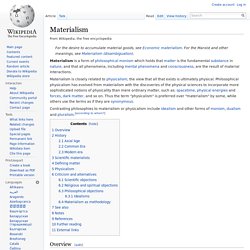
Materialism is closely related to physicalism; the view that all that exists is ultimately physical. Worldbuilding. Worldbuilding or conworlding is the process of constructing an imaginary world, sometimes associated with a whole fictional universe.[1] The resulting world may be called a constructed world.
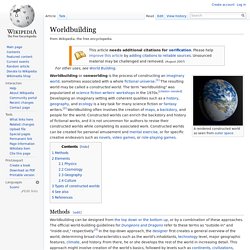
The term "worldbuilding" was popularized at science fiction writers' workshops in the 1970s. [citation needed] Developing an imaginary setting with coherent qualities such as a history, geography, and ecology is a key task for many science fiction or fantasy writers.[2] Worldbuilding often involves the creation of maps, a backstory, and people for the world. Constructed worlds can enrich the backstory and history of fictional works, and it is not uncommon for authors to revise their constructed worlds while completing its associated work. Constructed worlds can be created for personal amusement and mental exercise, or for specific creative endeavors such as novels, video games, or role-playing games. Methods[edit] Dream art. Pierre-Cécile Puvis de Chavannes: The Dream, 1883 Dream art is any form of art directly based on material from dreams, or which employs dream-like imagery.
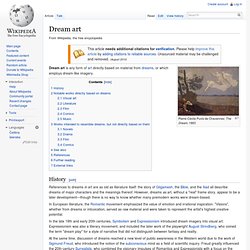
History[edit] References to dreams in art are as old as literature itself: the story of Gilgamesh, the Bible, and the Iliad all describe dreams of major characters and the meanings thereof. However, dreams as art, without a "real" frame story, appear to be a later development—though there is no way to know whether many premodern works were dream-based. Middle Ages. Pre-Raphaelite Brotherhood. The Pre-Raphaelite Brotherhood (also known as the Pre-Raphaelites) was a group of English painters, poets, and critics, founded in 1848 by William Holman Hunt, John Everett Millais and Dante Gabriel Rossetti.
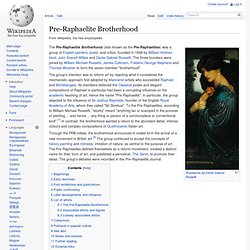
The three founders were joined by William Michael Rossetti, James Collinson, Frederic George Stephens and Thomas Woolner to form the seven-member "brotherhood". The group's intention was to reform art by rejecting what it considered the mechanistic approach first adopted by Mannerist artists who succeeded Raphael and Michelangelo. Gothic Revival architecture. Gothic Revival (also referred to as Victorian Gothic, Neo-Gothic or Jigsaw Gothic, and when used for school, college, and university buildings as Collegiate Gothic) is an architectural movement that began in the late 1740s in England.
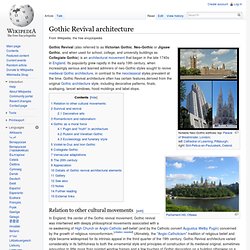
Its popularity grew rapidly in the early 19th century, when increasingly serious and learned admirers of neo-Gothic styles sought to revive medieval Gothic architecture, in contrast to the neoclassical styles prevalent at the time. Gothic Revival architecture often has certain features,derived from the original Gothic architecture style, including decorative patterns, finals, scalloping, lancet windows, hood moldings and label stops. Relation to other cultural movements[edit] The Gothic Revival was paralleled and supported by "medievalism", which had its roots in "antiquarian' concerns with survivals and curiosities. Romanticism. Defining Romanticism[edit] Basic characteristics[edit]
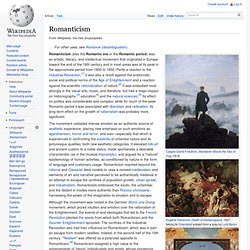
Medievalism. Medievalism is the system of belief and practice characteristic of the Middle Ages, or devotion to elements of that period, which has been expressed in areas such as architecture, literature, music, art, philosophy, scholarship, and various vehicles of popular culture.[1] Since the 18th century, a variety of movements have used the medieval period as a model or inspiration for creative activity, including Romanticism, the Gothic revival, the Pre-Raphaelite and arts and crafts movements and neo-medievalism (a term often used interchangeably with medievalism).
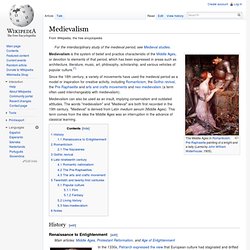
Medievalism can also be used as an insult, implying conservatism and outdated attitudes. Supernatural. The supernatural (Medieval Latin: supernātūrālis: supra "above" + naturalis "nature", first used: 1520–30 AD)[1][2] is that which is not subject to the laws of physics, or more figuratively, that which is said to exist above and beyond nature.

In philosophy, popular culture and fiction, the supernatural is associated with the paranormal, religions and occultism. It has neoplatonic[3] and medieval scholastic[4] origins. In Catholicism[edit] Fantastic art. Fantastic art is a broad and loosely-defined art genre.[1] It is not restricted to a specific school of artists, geographical location or historical period. It can be characterised by subject matter - which portrays non-realistic, mystical, mythical or folkloric subjects or events - and style, which is representational and naturalistic, rather than abstract - or in the case of magazine illustrations and similar, in the style of graphic novel art such as manga.
The subject matter of Fantastic Art may resemble the product of hallucinations, and Fantastic artist Richard Dadd spent much of his life in mental institutions. Salvador Dalí famously said: "the only difference between me and a madman is that I am not mad".[3] Some recent Fantastic Art draws on the artist's experience, or purported experience, of hallucinogenic drugs. Fantastic art has traditionally been largely confined to painting and illustration, but since the 1970s has increasingly been found also in photography. Esotericism. Realm.
A realm /ˈrɛlm/ is a community or territory over which a sovereign rules; it is commonly used to describe a kingdom or other monarchical or dynastic state. The Old French word reaume, modern French royaume, was the word first adopted in English; the fixed modern spelling does not appear until the beginning of the 17th century.
The word supposedly derives from medieval Latin regalimen, from regalis, of or belonging to a rex, (king).[1] "Realm" is particularly used for those states whose name includes the word kingdom (for example, the United Kingdom), to avoid clumsy repetition of the word in a sentence (for example, "The Queen's realm, the United Kingdom... "). It is also useful to describe those countries whose monarchs are called something other than "king" or "queen"; for example, the Grand Duchy of Luxembourg is a realm but not a kingdom since its monarch holds the title Grand Duke rather than King.
See also[edit] References[edit] Attribution.